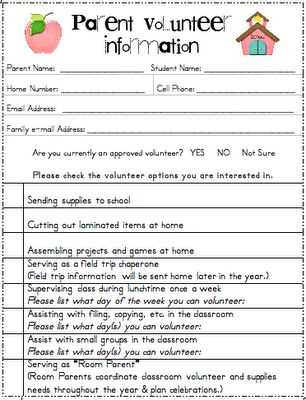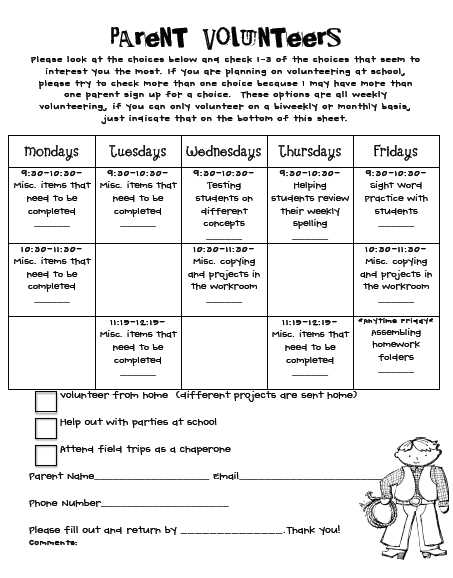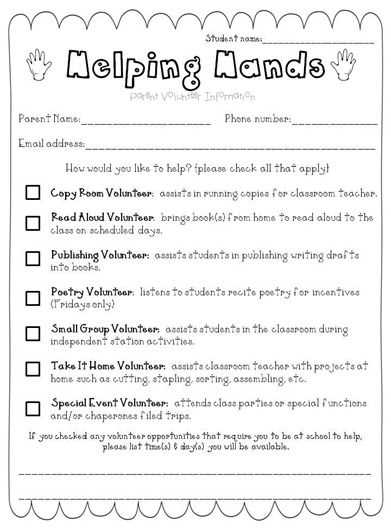Parent Volunteer Letter Template for School Activities

Schools thrive when communities come together to support educational initiatives. Involving caregivers in school functions fosters a sense of teamwork and collaboration, creating a more vibrant learning environment. By inviting contributions, schools can enhance their events and programs with the help of committed individuals.
Effective communication plays a crucial role in encouraging involvement. Crafting a clear and inviting message can make all the difference in motivating others to participate. With the right approach, reaching out to potential contributors becomes easier and more effective.
Building connections through well-crafted messages not only helps gather support but also strengthens the relationship between schools and families. This collaborative approach ensures that everyone has the opportunity to play a part in shaping a positive educational experience.
Why Supporters Are Essential

Active participation from caregivers and local community members greatly enhances the success of school activities and programs. When these individuals engage in educational events, they bring new perspectives, energy, and resources that can significantly benefit the overall learning experience. Their involvement not only supports the growth of the institution but also strengthens the bond between families and the school environment.
Improved Educational Outcomes
When caregivers take part in school initiatives, it often leads to better academic and social outcomes for students. Research shows that children whose families are actively engaged in school-related activities tend to perform better in class. This connection helps build a sense of pride, responsibility, and belonging among students, motivating them to excel in their studies.
Stronger Community Relationships
Involving caregivers creates a sense of unity and shared purpose, fostering stronger relationships within the community. When individuals come together for a common cause, they build trust and support networks that extend beyond the classroom. This network becomes a valuable resource for both families and the school, contributing to a more cohesive and collaborative environment for all involved.
Benefits of Involvement in Schools

When caregivers and community members actively engage in educational settings, the entire school ecosystem benefits. Their participation has a direct impact on student success, the development of a positive school culture, and the strengthening of school-family connections. Schools that encourage this collaboration see improvements across various areas, leading to a more enriched learning environment for all.
Enhanced Academic Performance
Students whose families take an active interest in their education tend to achieve higher academic results. This involvement helps create a support system that encourages students to excel and stay motivated throughout their academic journey. Some benefits include:
- Improved grades and test scores
- Increased student engagement
- Better behavior and attendance
Stronger School Community
A united effort between educators and families fosters a sense of belonging within the school. This strong community contributes to a positive environment where students, teachers, and caregivers feel connected and supported. The advantages of building such a community include:
- Increased trust and communication
- More collaborative problem-solving
- A supportive atmosphere for student growth
How to Write a Request for Support
When reaching out to individuals for assistance with school events or programs, a well-crafted message is key to ensuring a positive response. A clear and respectful request encourages recipients to consider contributing their time and efforts. Understanding the essential components of a compelling request can make the process of engaging others more effective and fruitful.
Key Elements to Include
To create a strong and persuasive message, it is important to include the following elements:
- Introduction: Briefly introduce yourself and the purpose of the request.
- Specific Request: Clearly outline what kind of help is needed, whether it’s time, skills, or resources.
- Benefits: Highlight how their involvement will make a positive impact on the school community.
- Contact Information: Provide clear instructions on how they can respond or get involved.
Best Practices for Crafting Your Message
Keep the tone friendly and appreciative, showing gratitude for any contribution. Be concise yet informative to respect the reader’s time. Additionally, make sure your message is personalized to make recipients feel valued and directly connected to the cause. A clear call to action will also encourage a prompt response.
Key Elements to Include in Your Message
Crafting an effective communication requires thoughtful consideration of its components. A well-structured request ensures clarity and encourages engagement. To maximize the chances of receiving a positive response, it’s important to address the right aspects in the message.
Essential Components
When drafting your communication, the following elements are crucial for conveying your purpose effectively:
| Element | Description |
|---|---|
| Clear Introduction | Briefly introduce who you are and the reason for the outreach. |
| Specific Request | Detail exactly what assistance is needed, including time and specific roles. |
| Impact | Explain how their participation will benefit the school and students. |
| Easy Call to Action | Provide clear steps on how they can get involved or respond. |
Effective Tone and Clarity
Maintain a respectful and friendly tone throughout the message. It’s essential to be concise while providing all the necessary information. This balance ensures that the reader understands the request without feeling overwhelmed by excessive details.
Best Practices for Effective Support Communication
Building strong relationships through communication is key to fostering a successful partnership between schools and community members. The way messages are conveyed can influence how people respond to requests for assistance. Employing effective communication strategies helps ensure that outreach efforts are productive and well-received.
To achieve optimal results, consider using these best practices in your communications:
- Be Clear and Direct: Ensure that the purpose of the message is easy to understand, with a clear request and expected outcome.
- Be Respectful: Approach the reader with gratitude and appreciation for their time, regardless of whether they can contribute.
- Be Timely: Send messages well in advance of any deadlines or events to give recipients enough time to respond or plan accordingly.
- Provide Clear Instructions: Make it easy for recipients to know how to respond, including any specific steps they need to take to get involved.
By applying these principles, the process of asking for help becomes smoother, and the chances of receiving a positive response are greatly increased.
Tips for Building Strong Relationships with Caregivers
Fostering positive and supportive relationships between schools and families is essential for creating a thriving educational environment. Strong connections not only improve communication but also encourage greater involvement and collaboration, benefiting both students and the wider community. Establishing trust and mutual respect is key to long-lasting partnerships.
To build these relationships effectively, consider these strategies:
- Open and Honest Communication: Keep caregivers informed about school events, updates, and student progress. Transparency fosters trust.
- Active Listening: Show genuine interest in their concerns and suggestions, making them feel valued and heard.
- Consistent Engagement: Regularly reach out, whether through meetings, emails, or other forms of communication, to maintain ongoing involvement.
- Encourage Participation: Provide clear opportunities for caregivers to get involved in activities, events, and decision-making processes.
- Show Appreciation: Acknowledge and celebrate the contributions and support of caregivers to strengthen the partnership.
By following these tips, schools can create a welcoming and inclusive atmosphere where families feel empowered to engage and contribute to their child’s education.